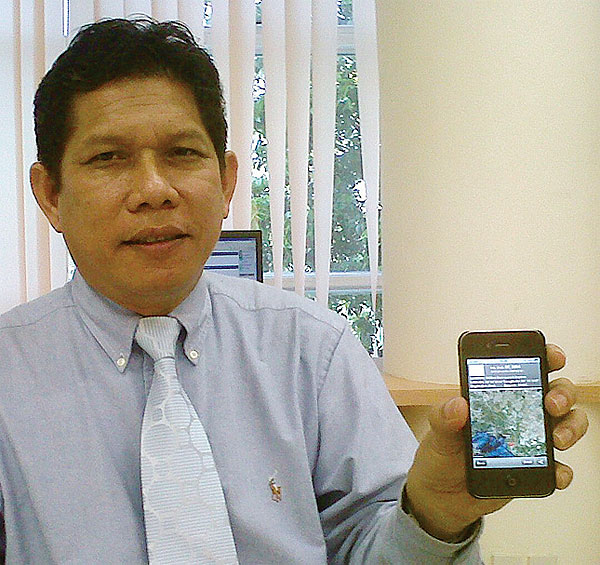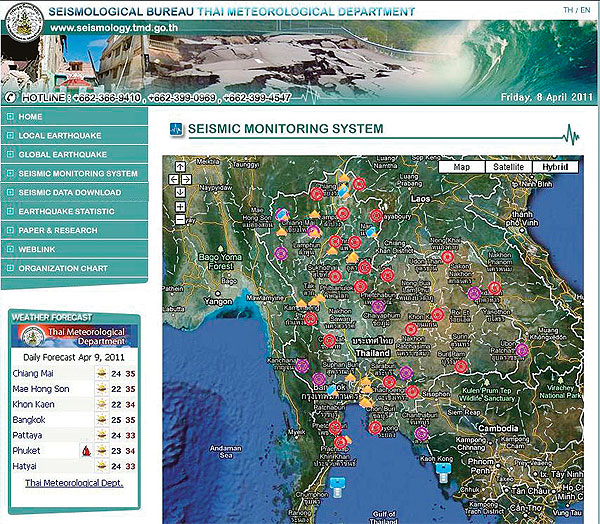Technologies to predict and monitor natural disasters are well advanced but need to be better coordinated.
- Published: 20/04/2011 at 12:00 AM
- Newspaper section: Business
Recent natural disasters such as the earthquake and tsunami in Japan, the quake in Burma and flooding and landslides in southern Thailand have focused people's attention on disaster preparedness.
 Mr Somsak shows a prototype application.
Mr Somsak shows a prototype application.High-speed telecoms infrastructure, including 3G and fixed-line broadband internet, could enhance the effectiveness of warning systems and ensure efficient operations when catastrophe strikes. Mobile technology can also play a significant role in highlighting specific risk areas by providing mobile disaster warnings.
The Meteorological Department is currently seeking fiscal budget approval of between 2.8 billion and 2.9 billion baht to improve its weather monitoring systems and speed up warning times.
Most of the 2012 budget, almost three times the normal level, would be allocated to weather radar, said Thosakdi Vanichikajorn, director-general of the department.
Weather radar is used to locate precipitation, calculate its motion, estimate types of rain and forecast its future position and intensity.
The money will also go to increase the number and capacity of automatic weather observation systems and automated weather stations, he said.
The department has more than 100 weather stations but 20 are currently closed for maintenance.
 A wide range of information is posted and updated regularly on the website of the Seismological Bureau.
A wide range of information is posted and updated regularly on the website of the Seismological Bureau.Mr Thosakdi said the department also aimed to make longer-range forecasts of five to seven days the norm, from three days now.
"Normally, we receive a fiscal budget around one billion baht annually," he said. Half of the budget pays for salaries of 900 staff and operating costs. leaving a relatively small amount for investment.
"Given the number of lives lost and the government's relief budget of up to 100 billion baht a year, more funds should be allocated to our department to reduce the risks of disasters," he said.
The Meteorological Department is working with volunteers to develop mobile weather mobile applications to run on iPhone, Android and BlackBerry devices. The data would be available to people in fields including tourism, agriculture, industry and aviation.
For example, a pilot could select data sources to display in an airplane cockpit.
"If we could successfully develop [this application] within this year, Thailand will lead this service innovation, putting the power of information in users' hands," said Mr Thosakdi.
He also urged the government to set a national standard for natural disaster warning. This would include a separate "voice" for emergency warnings. Currently, a single loudspeaker system in communities serves multiple public-address functions.
Mr Thosakdi says he favours four levels of warnings. The first would alert people of an incident that could happen within three days; the second in one to three days; the third within 24 hours and the fourth within three hours.
Somsak Khaosuwan, the director of the NDWC, said it was working with all mobile operators to send SMS warnings to people registered in areas facing disaster risk.
It has also used social media including Twitter and Facebook to provide information directly to online communities to dispel rumours and public panic.
Mr Somsak said his team was developing NDWC mobile apps for smartphones, starting with the iPhone.
He said the NDWC would act like an "emergency assistant digital manual" showing locations of public disaster relief and rescue centres, police stations and hospitals on maps near users' position, along with contact numbers.
Mr Somsak said a 3G high-speed wireless broadband network would be the best way to deliver information and pictures from disaster areas to the centre quickly for verification. For instance, people can use Skype on mobile while officers on the ground can take pictures of landslides.
These communications tools complement existing media including the TV Pool, telephone, fax, community radio and warning broadcast station, amateur radio, warning towers, and special radio receivers in small communities.
Mr Somsak said the NDWC really needed to upgrade its servers and expand bandwidth to accommodate the growing number of concurrent users at peak times on http://www.ndwc.go.th. Currently, the site can support 500 visitors per second but that number can triple or quadruple at times of crisis.
"Our goal is to use any technologies and communications channels that can extend our reach to the target audiences, especially in rural areas," he said.
"We hope to educate and raise awareness among people to prepare for any catastrophe in an effort to save people's lives and assets as much as possible."
read more: http://www.bangkokpost.com/tech/mobile/232749/the-power-of-preparedness
